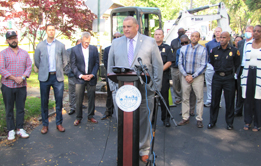
Sojourner’s Truth Staff
Mayor Wade Kapszukiewicz introduced his administration’s Toledo Recovery Plan on Wednesday, October 13, and outlined how he plans to spend the $180,948,591 that the City of Toledo will receive from the American Recovery Act – half of which was received in May 2021, the remainder in May 2022.
“Every Toledoan, in every neighborhood, will benefit from the Toledo Recovery Plan,” said the mayor at the start of his press conference outside the home of residents in the Old West End who will benefit from the replacement of lead water service lines.
The largest portion of the funds, according to the administration’s proposal, which has to be approved by City Council, will be allocated to “avoiding cuts to city services,” that is: “maintaining Toledo Police Department and Toledo Fire Department forces at needed levels … ensuring competitive wages for all City employees … support[ing] essential City services and allow[ing] … dollars to be invested in capital improvements …”
That total of $72.3 million represents the lion’s share of the allocations.
The funding will allow the city to add over 100 police officers by 2026 and raise the total number of officers to the 700 level that existed 20 years ago. The depletion, noted Kapszukiewicz, began in 2006 when a previous administration (led by then-Mayor Carty Finkbeiner, and Kapszukiewicz’s opponent in the upcoming mayoral campaign) laid off police officers for budgetary purposes.
“It was a disastrous decision to lay off police officers in 2006,” said the mayor. “They used the police department to balance the budget.”
Kapszukiewicz added that he had already added 32 officers for a net gain after 12 years of decline in the numbers.
During the press conference the mayor frequently stated that the plan assembled by his administration was a direct result of the public input received during the community forums held in recent months.
“Toledo, this is your plan. You helped create it,” he said.
Citizens’ input, gathered from a half dozen community forums, demonstrated that the clear cut, number one priority was for addressing housing issues and, specifically, replacing lead water service lines. To that end, all such public and private lines will be replaced in the city at a anticipated cost of $10 million. Private lines, noted the mayor, are legally the homeowners’ responsibility, so such an investment, for about 3,000 private lines, will save thousands of dollars for such homeowners.
In addition to the beefed-up safety forces and the lead pipe replacement program, Kapszukiewicz touted plans that will: spend $40.5 million on youth programming and initiatives; construct a new Wayman Palmer YMCA; build 500 new housing units, demolish hundreds of commercial and residential buildings; fight blight, fix sidewalks, plant trees, improve parks and create jobs.”
“We built this plan around input, we are listening to our citizens,” said the mayor.
The plan next goes to City Council for their input and certainly there will be tweaks to the allocation of funds. The mayor will place the plan before Council during the October 19 agenda review meeting and there could be a vote as early as October 26.
The details will also have to be vetted to ensure the funding suggestions meet federal requirements. Council members have already indicated they will do this. The federal government has laid out allowable uses a: municipal revenue loss, premium pay, infrastructure (water, sewer and broadband) and responding to the public health emergency and its economic impacts.
